İstanbul
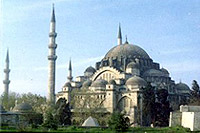 Eyüp Sultan Mosque: It is the first mosque constructed in Istanbul after conquer. It is constructed in 1458 by Fatih Sultan Mehmet, together with mausoleum. Today’s mosque is the mosque constructed under supervision of Hüseyin Efendi with demolishing the former mosque until to its base in 1800.
Eyüp Sultan Mosque: It is the first mosque constructed in Istanbul after conquer. It is constructed in 1458 by Fatih Sultan Mehmet, together with mausoleum. Today’s mosque is the mosque constructed under supervision of Hüseyin Efendi with demolishing the former mosque until to its base in 1800.
Eyüp Sultan Mausoleum: Halit Bin Zeyd (Hz. Eyup) the standard bearer of the Prophet Mohammed, and accepted the Islam first while he came to Mecca, is lying in the mausoleum, constructed in 1458. Eyüp, during the seventh Arabic siege of the Istanbul, had participated to the war in the army leaded by one of the Emevi rulers Ebu Süfyan and martyred. Eyup’s cemetery outside the ramparts is found by the teacher of Fatih, Akşemsettin after the conquer of Istanbul. Fatih, had constructed a mausoleum on this cemetery and a mosque near to it.
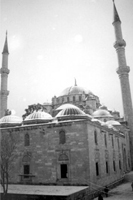
Fatih Mosque: The Imperial Fatih Mosque, constructed in between 1462 and 1470, bears the name of the Ottoman conqueror of Istanbul, Fatih Sultan Mehmet, and is the site of his mausoleum. Standing atop another of Istanbul's hills, its vast size and great complex of religious buildings - medreses, hospices, baths, a hospital, a caravanserai and a library make it well worth a visit.
Süleymaniye Mosque and Kulliye: The cascading domes and four slender minarets of the Imperial Suleymaniye Mosque dominate the skyline on the Golden Horn's west bank. Considered the most beautiful of all imperial mosques in Istanbul, it was built in between 1550 and 1557 by Sinan, the renowned architect of the Ottoman Empire's golden age. Erected on the crest of a hill, the building is conspicuous for its great size, emphasized by the four minarets that rise from each comer of the courtyard. Inside the mihrab (prayer niche showing the direction to Mecca) and the mimber (pulpit) are made of finely carved white marble and exquisite stained-glass windows, coloring the incoming streams of light. It was in the gardens of this complex that Suleyman and his wife, Hurrem Sultan (Roxelane), had their mausolea built, and near here also Sinan built his own tomb. The mosque complex also includes four medreses, or theological schools, a school of medicine, a caravanserai, a Turkish bath, and a kitchen and hospice for the poor.
 Detailed Information
Detailed Information
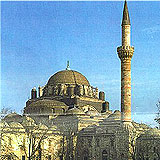 Beyazit Mosque: It is at the square of Beyazit, which is mentioned with its name. This great mosque and ıts külliye, (theology school, school, imaret, caravansary and hamam), is constructed by son of Fatih, II. Bayezit in 1501 - 1506. It has two minarets which are 87 meters away from each other. Plan of the Beyazit Mosque is similar to Aya Sofya. But it is separated from it with especially a perfect architectural application which includes a different characteristic having worship order of a culture.
Beyazit Mosque: It is at the square of Beyazit, which is mentioned with its name. This great mosque and ıts külliye, (theology school, school, imaret, caravansary and hamam), is constructed by son of Fatih, II. Bayezit in 1501 - 1506. It has two minarets which are 87 meters away from each other. Plan of the Beyazit Mosque is similar to Aya Sofya. But it is separated from it with especially a perfect architectural application which includes a different characteristic having worship order of a culture.
Sultanahmet Mosque Detailed Information
Mimar Sinan Mausoleum: It is at the courtyard of Süleymaniye mosque. Head Architect Sinan (dec. 1588) is constructed this attractive, beautiful and simple outstanding mausoleum for himself. Structure, is reflecting the simplicity and elegancy, which complies with the geniusness of the master.
Sultan Selim Mosque: It is around Edirnekapı, at Sultan Selim region. It is completed in 1522 during Kanuni Sultan Süleyman period. In the writing at main entrance, it is recorded that its construction is ordered by I. Selim, and according to some sources it is said that it is constructed by his son in the memory of his father.
Haseki Mosque: Architect of this piece of art which is constructed in 1538 in the memory of Kanuni Sultan Süleyman's wife, Hürrem Sultan, is Sinan. There is an elegant kulliye composed of theology school, darüşşifa, imaret and public fountain, around it. It is widened in 1612 during I. Ahmet period.
Yeni Mosque: It is in Eminönü. When mosque construction, which is started in 1597 by III. Mehmet's mother, Safiye Sultan, had reached to window level, ruler and his mother had died. Uncompleted construction is completed with the desire of IV. Mehmet’s mother, Turhan Sultan in 1663.
Şahzade Mosque: It is in Saraçhane across the Minicipality Palace. Kanuni, ordered Mimar Sinan to construct a mosque in memory of his son Mehmet who died in 1543, and construction strated in 1544, completed in 1548. Mosque, which is at the city center, is in the middle of a complex composed of theology schools, mausoleums, tabhane and imaret.
Nuruosmaniye Mosque: It is in Nuruosmaniye entrance of closed bazaar. Construction this mosque is commenced by I. Mahmut in 1748, and completed in 1755 during III. Osman due to his death.
Rüstempaşa Mosque: It is constructed to Mimar Sinan in 1561 by one of the viziers of Kanuni, Rüstem Paşa. As the place at Eminönü is both hollow and a commercial center, Sinan, had opened inns and shops under mosque.
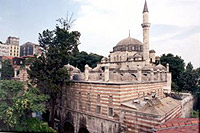 Sokullu Mehmet Paşa Mosque: It is in Kadırga. It is constructed to Mimar Sinan in 1671 by III. Selim's daughter, Esmehan Sultan, in memory of her husband, Vizier Mehmet Paşa. Inside of the mosque is adorned with the most beautiful tiles of the period till to the feet of the dome. Balcony cone is also tiled.
Sokullu Mehmet Paşa Mosque: It is in Kadırga. It is constructed to Mimar Sinan in 1671 by III. Selim's daughter, Esmehan Sultan, in memory of her husband, Vizier Mehmet Paşa. Inside of the mosque is adorned with the most beautiful tiles of the period till to the feet of the dome. Balcony cone is also tiled.
Yeni Valide Mosque: It is in Üsküdar. It is constructed as a kulliye by III. Ahmet's mother, Gülnuz Sultan on 1710. It has two minarets and double niches.
Bezm-i Alem Valide Sultan (Dolmabahçe) Mosque: As it is understood from the inscription of Poet Ziver on the courtyard's door, Valide Sultan had started the construction of the mosque, and her son Abdülmecit had completed it in 1853.
In 1848, its siege ramparts are removed and a naval museum is established within the mosque.
İmrahor İlyas Bey Mosque (Studios Monastery): It is constructed between Samatya and Yedikule on 463. The building, which is one of the former buildings of Istanbul, is devoted to baptist Yohannes. The 13th century floor mosaics can be seen on the floor of the building.After the conquest of İstanbul, the structure was converted int o a mosque by İlyas Bey in 1486. Afterwards the building had been exposed to various damages as a result of various earthquakes and fires, and in 1908 its roof collapsed and rendered any kind of restoration impossible;therefore the mosque still bares its destructed view.
Former İmaret Mosque (Pantepoptes Monastery Church): It is on the slope, which descents from Fatih to Haliç, and belongs to the beginning of II. century. It is constructed by I. Alexios's mother, Anna Dalaena. It is the most beautiful sample of period.
Neve Şalom Synagogue: Name of the synagogue, which is at Galata, on Büyük Hendek Street, means "Peace Oasis". 25th March, 1951 opened this synagogue is still the most modern and magnificent synagogue of İstanbul, and witnessed a lot of religious ceremony, such as wedding, bar, mitzva (maturity ceremony) and funeral, or Head Rabbinate Appointment (Hahambaşılık İs'ad) ceremonies.
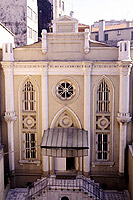 Italian Synagogue: It is in Galata, at Poet Ziya Paşa Slope. This synagogue, which is especially Italian and Austrian nationality holding Hebrews, who live in Ottoman Empire, begin to serve in 1886.
Italian Synagogue: It is in Galata, at Poet Ziya Paşa Slope. This synagogue, which is especially Italian and Austrian nationality holding Hebrews, who live in Ottoman Empire, begin to serve in 1886.
Aşkenazi Synagogue: This synagogue is among the other synagogues of Jewish people belonging to Aşkenaz community living in İstanbul and the only one that has still been in service.
Loacted at Yüksek Kaldırım Street at Galata, the synagogue was constructed by Aşkenaz people of Austrian origin. With its facade in European style and the decoration of its Ehal and Teva( prayer desk) in wooden pagoda style with Polish influence,the synagogue displays a different view when compared to traditional Sefarad and Romaniot synagogues.
Zülfaris Synagogue: Located at Galata quarter and have been present from the 17th century, the current building of the synagogue belongs to 19th century.
The synagogue, in which religious ceremonies were carried out before the construction of Neve Şalam Synagogue, have been not in service recently. However within the frame of the 1992 celebrations organization, the synagogue is determined to be converted into "500 Years Tranquil Life Musuem" without any effect on the religious appearance of the structure.
Ahrida Synagogue: Located at Balat, the synagogue was built by those who had migrated to Macedonia from Ahri borough in 15th century. Having a similar shape to a ship's bow, Teva( prayer desk) of the synagogue to some resembles to Noah's Ship while others compare it to Ottoman galleys that carried Sefarad immigrants to the Ottoman piers from Spain. Being in service over 500 years, the synagogue has been exposed to some fires and repaired . Moreover, embracing the most ancient appearance among the others included within frame of 500th annual celebratons programme, it was restored in Lale(Tulip) Period baroque style.
Yanbol Synagogue: Located at Balat and built and named by the people migrating from Yanbolu borough in Macedonia, the synagogue is the second ancient Jewsih structure of the region. The paintings on the ceiling of the synagogue are though to be depicting Yanbolu Borough.
Haydarpaşa Hemdat Israel Synagogue: Located at a close distance to Haydarpaşa Train Station,and derived its name from its story of foundation, the synagogue was put into service in Sept.3, 1989. That is the name "Hemdat Israel" which means "the mercy of the sons of Israel" was inspired from the arabic words "Hamid" and "Hemdat" written on the synagogue as the sign of gratitude for Abdülhamit II. who had surpassed the chaos let by those who were against the construction of the synagogue.
Etz Ahayim Synagogue (Ortaköy): Becoming an appropriate residential for the Jewsih people who settled there after the great bedesten( bazaar) fire in 1618, Ortaköy where Jewish people already had lived from the ancient times, formed a model of harmony with three celestial religion performed in the mosque, synagogue and church located at a triangular area. Signifying the meaning of "Life Tree", Ortaköy Etz Ahayim Synagogue dated back to 17th century,which is derived from the documents of maintanance. The building was totally destructed in the fire in 1941 and today only the Ehal (case in which the manuscript parchments of the copy of the Pentateuch were kept) at the side of the garden of the building facing the sea have remained.